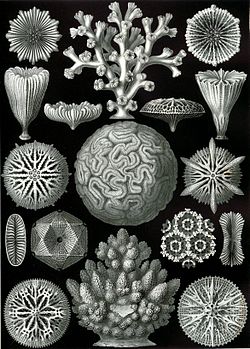Scleractinia
| Stony corals Temporal range: Middle Triassic – Recent |
|
|---|---|
 |
|
| Scleractinian corals, illustration by Ernst Haeckel, 1904 |
|
| Scientific classification | |
| Kingdom: | Animalia |
| Phylum: | Cnidaria |
| Class: | Anthozoa |
| Subclass: | Hexacorallia |
| Order: |
Scleractinia Bourne, 1900 |
| Families | |
|
About 35, see text. |
|
| Synonyms | |
|
Madreporaria |
|
About 35, see text.
Madreporaria
Scleractinia, also called stony corals or hard corals, are marine animals in the phylum Cnidaria that live on the seabed and build themselves a hard skeleton. The individual animals are known as polyps and have a cylindrical body crowned by an oral disc with a mouth and a fringe of tentacles. Although some species are solitary, most are colonial. The founding polyp settles on the seabed and starts to secrete calcium carbonate to protect its soft body. Solitary corals can be as much as 25 cm (10 in) across but in colonial species the polyps are usually only a few millimetres in diameter. These polyps reproduce by budding but remain attached to each other, forming a multi-polyp colony with a common skeleton, which may be up to several metres in diameter or height according to species.
The shape and appearance of each coral colony depends not only on the species, but also on its location, depth, the amount of water movement and other factors. Many shallow-water corals contain symbiont unicellular organisms known as zooxanthellae within their tissues. These give their colour to the coral which thus may vary in hue depending on what species of symbiont it contains. Stony corals are closely related to sea anemones, and like them are armed with stinging cells known as cnidocytes. Corals reproduce both sexually and asexually. Most species release gametes into the sea where fertilisation takes place, and the planula larvae drift as part of the plankton, but a few species brood their eggs. Asexual reproduction is mostly by fragmentation, when part of a colony becomes detached and reattaches elsewhere.
Stony corals occur in all the world's oceans. Hermatypic corals are mostly colonial and form part of reef structures; most of these are zooxanthellate and are found in the shallow waters into which sunlight penetrates. Other corals may be solitary or colonial and do not form reefs; some of these occur at abyssal depths where no light reaches. Stony corals first appeared in the Middle Triassic, but their relationship to the tabulate and rugose corals of the Paleozoic is currently unresolved. Much of the framework of modern coral reefs is formed by scleractinians. Stony corals numbers are expected to decline due to the effects of global warming and ocean acidification.
...
Wikipedia
